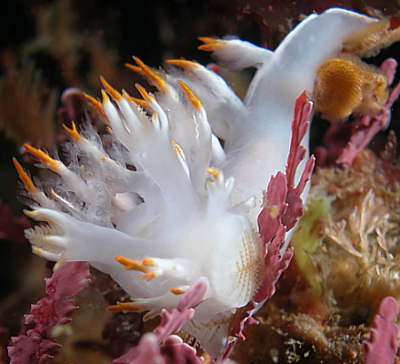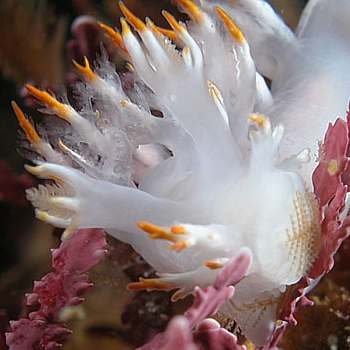Food of Dendronotus albus
September 16, 2003
From: Ken Ashman


Can you reccomend a good reference for Pacific opisthobranchs covering the Californian coast?
This Dendronotus albus is feeding on a hydroid. I noticed the color of the cerata and processes mirror the hydroid's - is there a correlation? I'd love to have a resource I could take on dive trips where I could look up information along these lines re behaviors and habits of branchs...
I own David Behrens' fine photo-guide, but I'm wanting addittional references to answer these deeper questions.
Ken Ashman
ken@cadigitaldiving.com
Ashman, K., 2003 (Sep 16) Food of Dendronotus albus. [Message in] Sea Slug Forum. Australian Museum, Sydney. Available from http://www.seaslugforum.net/find/10969Dear Ken,
Thanks for the photo. Concerning a book, I was going to mention Dave Behren's book, but if you are looking for more in depth information on Californian opisthobranchs then you will need to go back to the scientific literature, for as far as I know there is nothing in between. I am afraid that although there are books such as you envisage for many vertebrate groups, such as birds, mammals, reptiles etc, and possibly butterflies amongst the invertebrates, there are not similar books for most invertebrate groups. One major reason for this is that we still don't know most things about most invertebrate species. Although we have a general understanding of the biology of many families, when we get down to individual species, we are pretty clueless. One reason for the Forum is to give interested amateurs the opportunity to help us learn more about the biology and natural history of opisthobranchs. By accumulating photos and observations on the Forum we are building up a store of information on many aspects of these animals' biology and natural history.
Concerniing your question about its colour pattern, we have to be careful correlating such things as the colour of parts of an animal and thegeneral aspects of this on a separate page. Some species do accumulate pigments from their food so that they are camouflaged. However I doubt that Dendronotus albus, which is essentially large and white, would gain much protection from potential prey by having orange-tipped processes, since the orange hydroid it seems to be eating is much smaller. But I could be wrong. One other point which complicates things is that Dendronotus albus is reported to eat a variety of hydroid species, not all of which are orange.
Any observations and questions are welcome. I can't guarantee to have an answer for them all, but with the help of other Forum participants, which should be able to give you a 'state of the art' answer - if we have one.
Best wishes,
Bill Rudman
Related messages
-
Dendronotus albus from Vancouver Island
From: Mark Lloyd, September 24, 2007 -
Dendronotus diversicolor eggs
From: Jackie Hildering, August 6, 2007 -
Dendronotus albus - new record from Korea
From: Dong Bum Koh, April 6, 2006 -
Two colour forms of Dendronotus albus?
From: Dr. Steve Lonhart, October 15, 2005 -
Colour forms of Dendronotus albus
From: Jim Lyle, May 16, 2005 -
Dendronotus albus from California
From: Bruce Wight, August 11, 2004 -
Photos of Dendronotus albus
From: Clinton Bauder, August 13, 2001
